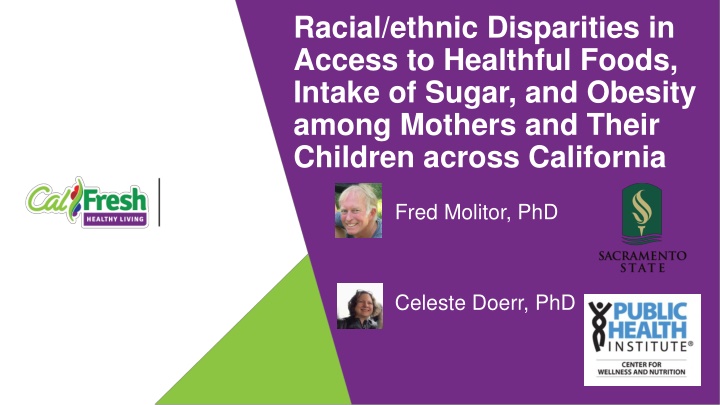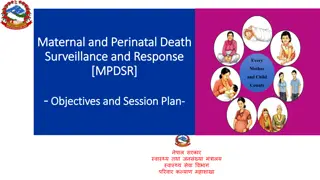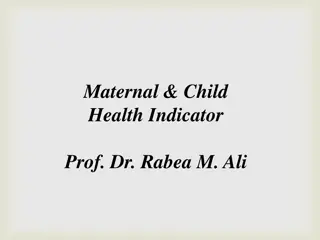
Exploring Racial/Ethnic Disparities in Healthful Food Access and Obesity Among California Mothers and Children
Investigating racial/ethnic disparities in access to healthful foods, sugar intake, and obesity among mothers and children in California. The study focused on low-income households and found variations across different racial and ethnic groups.
Download Presentation

Please find below an Image/Link to download the presentation.
The content on the website is provided AS IS for your information and personal use only. It may not be sold, licensed, or shared on other websites without obtaining consent from the author. If you encounter any issues during the download, it is possible that the publisher has removed the file from their server.
You are allowed to download the files provided on this website for personal or commercial use, subject to the condition that they are used lawfully. All files are the property of their respective owners.
The content on the website is provided AS IS for your information and personal use only. It may not be sold, licensed, or shared on other websites without obtaining consent from the author.
E N D
Presentation Transcript
Racial/ethnic Disparities in Access to Healthful Foods, Intake of Sugar, and Obesity among Mothers and Their Children across California Fred Molitor, PhD Celeste Doerr, PhD
Introduction Disparities have been reported across racial/ethnic groups for unhealthful dietary behaviors and obesity.
Objective Our objective is to examine unhealthful dietary behaviors and obesity as well as access and availability to healthful foods across racial/ethnic groups for mothers and children from low-income households throughout California.
California Family Health Study Mothers and children (5-11 years) were recruited from randomly- sampled households with incomes 185% of the federal poverty level across California. Before telephone interviews, households were sent pictorial food and beverage portion-size booklets and measuring cups and spoons, as well as a tape measure and instructions for recording height. The ASA24 was used to assess the quantity and size of each food and drink item consumed for each meal and snack over the prior 24 hours.
California Family Health Study Supplemental items were used to assess height and weight; demographics; the availability of fruits and vegetables (FV), and healthy foods in general, in one s neighborhood; and the availability of FV to household family members. Mothers with a BMI 30 were classified as obese; BMI-for- age-and-gender percentile rankings were used for children. Comparisons across racial/ethnic groups controlled for age, education for mothers, and gender for children.
California Family Health Study, 2015 to 2017 Mothers 13,793 12.9% 64.3% 16.5% Children 6,160 13.7% 68.6% 16.7% Complete Interviews African American Latinx White
Obesity Mothers 53.5b 45.7a 44.0a Children 31.8b 28.8b 22.3a African American Latinx White
Mothers Per Day Intake Teaspoons of Added Sugars 13.4c 10.7a 12.5b Ounces of SSBs 9.5b 7.9a 9.0b African American Latinx White
FV Availability FV readily available in neighborhood 26.4a 23.1a 35.1b FV ready-to-eat for family at home 27.5a 34.6b 38.1b African American Latina White
Discussion In California over half of African American mothers, and nearly one-third of African American children, from low-income households are obese. These mothers and their children have restricted access to FV and healthier foods in the community and at home compared with white families. The focus of obesity prevention efforts must be on African American families and should include addressing environmental factors related to the increased risk of elevated body mass.
Limitations Self-reported data, including height and weight. Response rates for mothers never reached 50%. However, over 58% of non-response can be attributed to non-contact with sampled households. While our findings may be generalized to mothers and children from SNAP-Ed eligible households, the degree to which they are applicable to other low-income, at-risk populations within and outside California is unknown.
Questions Fred Molitor fred.molitor@csus.edu Celeste Doerr celeste.doerr@wellness.phi.org






















